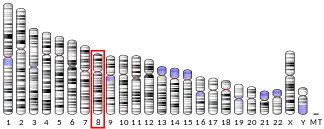SGCZ
Sarcoglycan zeta also known as SGCZ is a protein which in humans is encoded by the SGCZ gene.[5]
| SGCZ | |||||||||||||||||||||||||||||||||||||||||||||||||||
|---|---|---|---|---|---|---|---|---|---|---|---|---|---|---|---|---|---|---|---|---|---|---|---|---|---|---|---|---|---|---|---|---|---|---|---|---|---|---|---|---|---|---|---|---|---|---|---|---|---|---|---|
| Identifiers | |||||||||||||||||||||||||||||||||||||||||||||||||||
| Aliases | SGCZ, ZSG1, sarcoglycan zeta | ||||||||||||||||||||||||||||||||||||||||||||||||||
| External IDs | OMIM: 608113 MGI: 2388820 HomoloGene: 26726 GeneCards: SGCZ | ||||||||||||||||||||||||||||||||||||||||||||||||||
| |||||||||||||||||||||||||||||||||||||||||||||||||||
| |||||||||||||||||||||||||||||||||||||||||||||||||||
| |||||||||||||||||||||||||||||||||||||||||||||||||||
| |||||||||||||||||||||||||||||||||||||||||||||||||||
| Wikidata | |||||||||||||||||||||||||||||||||||||||||||||||||||
| |||||||||||||||||||||||||||||||||||||||||||||||||||
Function
The zeta-sarcoglycan gene measures over 465 kb and localizes to 8p22. This protein is part of the sarcoglycan complex, a group of 6 proteins. The sarcoglycans are all N-glycosylated transmembrane proteins with a short intra-cellular domain, a single transmembrane region and a large extra-cellular domain containing a carboxyl-terminal cluster with several conserved cysteine residues. The sarcoglycan complex is part of the dystrophin-associated glycoprotein complex (DGC), which bridges the inner cytoskeleton and the extracellular matrix.[6]
Clinical significance
Zeta-sarcoglycan is reduced in mouse models of muscular dystrophy and SGCZ is found as a component of the vascular smooth muscle sarcoglycan complex. Hence SGCZ may be important in the pathogenesis of muscular dystrophy.[5]
References
- GRCh38: Ensembl release 89: ENSG00000185053 - Ensembl, May 2017
- GRCm38: Ensembl release 89: ENSMUSG00000039539 - Ensembl, May 2017
- "Human PubMed Reference:". National Center for Biotechnology Information, U.S. National Library of Medicine.
- "Mouse PubMed Reference:". National Center for Biotechnology Information, U.S. National Library of Medicine.
- Wheeler MT, Zarnegar S, McNally EM (September 2002). "Zeta-sarcoglycan, a novel component of the sarcoglycan complex, is reduced in muscular dystrophy". Hum. Mol. Genet. 11 (18): 2147–54. doi:10.1093/hmg/11.18.2147. PMID 12189167.
- "Entrez Gene: SGCZ Sarcoglycan zeta".
Further reading
- Strausberg RL, Feingold EA, Grouse LH, et al. (2002). "Generation and initial analysis of more than 15,000 full-length human and mouse cDNA sequences". Proc. Natl. Acad. Sci. U.S.A. 99 (26): 16899–903. Bibcode:2002PNAS...9916899M. doi:10.1073/pnas.242603899. PMC 139241. PMID 12477932.
- Anastasi G, Cutroneo G, Sidoti A, et al. (2007). "Sarcoglycan subcomplex expression in normal human smooth muscle". J. Histochem. Cytochem. 55 (8): 831–43. doi:10.1369/jhc.6A7145.2007. PMID 17438352.
- Aurino S, Piluso G, Saccone V, et al. (2008). "Candidate-gene testing for orphan limb-girdle muscular dystrophies". Acta Myol. 27: 90–7. PMC 2858943. PMID 19472918.
- Gerhard DS, Wagner L, Feingold EA, et al. (2004). "The status, quality, and expansion of the NIH full-length cDNA project: the Mammalian Gene Collection (MGC)". Genome Res. 14 (10B): 2121–7. doi:10.1101/gr.2596504. PMC 528928. PMID 15489334.
This article incorporates text from the United States National Library of Medicine, which is in the public domain.



